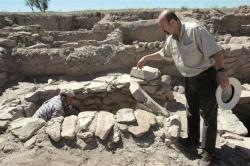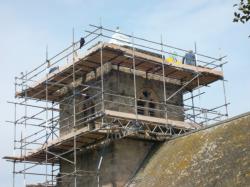INSTITUT SUPERIEUR D'ANTHROPOLOGIE
INSTITUTE OF ANTHROPOLOGY
ONLINE COURSES / COURS A DISTANCE
SUMMER TERM : JULY 2014
REGISTER NOW
TURQUIE –  Kültepe-Kaniş-Karum - Archaeologists working on the Kültepe-Kaniş-Karum trade colony in the Central Anatolian province of Kayseri have discovered a trade document believed to be the world’s oldest. Ankara University Archaeology Department academic and the head of the excavations, Professor Fikri Kulakoğlu, said the artifact mentioned the payment of a “donkey debt.” “We found an interesting thing in the grave. For the first time in Kültepe, a tablet was found in a grave. We were very happy. We thought that it was a prayer text for the dead to pass to the other world easily. We had a philologist friend and he read it. It turned out to be a text about the sale of a donkey. It was a surprise for us. The text says ‘when you read this letter of me, go to the owner of the donkey and give him silver,’” the professor said. Kulakoğlu said the region was known as the place where writing was first used in Anatolia. Speaking about this year’s goals in the excavations, the professor said: “This is one of the largest settlements in Asia Minor and one of the largest ones of the ancient world with an area of three square kilometers. This year our goal is to unearth a big palace-like structure in Kültepe. We will work there for four-five months there. On the other hand, we will find the neighborhoods and houses where Assyrian traders lived.” Kaniş-Karum was home to some 25,000 tablets and the colony is a candidate to join the UNESCO World Heritage List, he said.
Kültepe-Kaniş-Karum - Archaeologists working on the Kültepe-Kaniş-Karum trade colony in the Central Anatolian province of Kayseri have discovered a trade document believed to be the world’s oldest. Ankara University Archaeology Department academic and the head of the excavations, Professor Fikri Kulakoğlu, said the artifact mentioned the payment of a “donkey debt.” “We found an interesting thing in the grave. For the first time in Kültepe, a tablet was found in a grave. We were very happy. We thought that it was a prayer text for the dead to pass to the other world easily. We had a philologist friend and he read it. It turned out to be a text about the sale of a donkey. It was a surprise for us. The text says ‘when you read this letter of me, go to the owner of the donkey and give him silver,’” the professor said. Kulakoğlu said the region was known as the place where writing was first used in Anatolia. Speaking about this year’s goals in the excavations, the professor said: “This is one of the largest settlements in Asia Minor and one of the largest ones of the ancient world with an area of three square kilometers. This year our goal is to unearth a big palace-like structure in Kültepe. We will work there for four-five months there. On the other hand, we will find the neighborhoods and houses where Assyrian traders lived.” Kaniş-Karum was home to some 25,000 tablets and the colony is a candidate to join the UNESCO World Heritage List, he said.
http://www.hurriyetdailynews.com/tablet-about-payment-of-donkey-debt-discovered-in-kultepe-believed-to-be-oldest-trade-document.aspx?pageID=238&nID=68429&NewsCatID=375
ROYAUME UNI – Lewes - An investigation of a medieval drainage culvert at the Priory of St Pancras in Lewes was launched on Friday. The Trust is hoping to discover both the direction and purpose of this culvert, which lies beneath the monks’ latrine block, and to discover more about the eating habits of the monks and the environment in which they lived. Remotely-operated cameras were sent into the stone-lined vaulted culvert and detailed images were relayed and recorded for closer examination and the direction of the drain was plotted from signals sent to the surface. After a distance of 17 metres the culvert appeared to have been deliberately blocked, possibly as a result of the building of the monks’ Refectory. Archaeologists will now study the results of this survey to determine whether to extract sediments from the floor of the culvert for analysis and whether to re-open a partial excavation made in the 1970s of one of the main drains of the Priory.Founded in the 11th century by monks from Cluny in France, the Priory of St Pancras survived until the Dissolution of the Monasteries in 1537.
Lewes - An investigation of a medieval drainage culvert at the Priory of St Pancras in Lewes was launched on Friday. The Trust is hoping to discover both the direction and purpose of this culvert, which lies beneath the monks’ latrine block, and to discover more about the eating habits of the monks and the environment in which they lived. Remotely-operated cameras were sent into the stone-lined vaulted culvert and detailed images were relayed and recorded for closer examination and the direction of the drain was plotted from signals sent to the surface. After a distance of 17 metres the culvert appeared to have been deliberately blocked, possibly as a result of the building of the monks’ Refectory. Archaeologists will now study the results of this survey to determine whether to extract sediments from the floor of the culvert for analysis and whether to re-open a partial excavation made in the 1970s of one of the main drains of the Priory.Founded in the 11th century by monks from Cluny in France, the Priory of St Pancras survived until the Dissolution of the Monasteries in 1537.
http://www.sussexexpress.co.uk/news/local/culvert-probe-may-shed-new-light-on-lewes-priory-1-6146117
USA – Rutherford - In Rutherford County, history is about to get rewritten by MTSU professor Tanya Peres. Peres recently launched the Rutherford County Archaeology Research Program, an initiative to explore and record the prehistoric cultures of the county. Since the birth of the United States, it was believed that no ancient people lived in Rutherford County. That theory dates back to 1776 when explorer James Adair met with a group of Native Americans at Black Fox Springs near present day Murfreesboro. "They told him this area was just used as a hunting ground," Peres said. And until recently, the archaeological record has supported this theory. Since the Tennessee Division of Archaeology began recording sites, more than 1,300 prehistoric sites have been found in Williamson and Davidson counties. "Rutherford County only has 275. That is not even half of one of those counties," Peres said. Peres is conducting an archaeological field school for MTSU students at the Magnolia Valley equestrian farm in Eagleville. Peres explained she chose Magnolia Valley because former student Jesse Tune suggested they use his mother's land in Eagleville. Mary Tune purchased the land in 2006 and her son, being a curious archaeologist, did some digging in 2008 and found artifacts that suggested humans lived on the farm in the Paleo Era, which dates roughly from 10,000 to 20,000 years ago, to the Archaic Era, which dates roughly from 3,000 to 10,000 years ago.
http://www.knoxnews.com/news/2014/jun/29/group-doing-archaeological-digs-in-rutherford/
ROYAUME UNI -  Driffield - St. Mary’s Church, Little Driffield had its last quinquennial inspection in mid 2010 and it soon became obvious that the fourteenth/fifteenth century church tower was in need of urgent attention and also the south wall. In late May 2013 investigations took place with an inspection of the tower walls and tower roof, using a hydraulic platform; the drainage system and interior woodwork. All the interior pews on the south side were taken out and rotten wood panelling removed to expose the south wall. The floor boarding and joists all needed replacing as there was a great deal of rot. The south wall was also exposed on the outside by digging a trench down to the interior floor level. This digging revealed some interesting archaeology from the mediaeval period. The bases of a number of pillars were exposed; these originally carried arches, indicating St. Mary’s once had a south aisle (we know this from a report by Stukeley in 1740 who said “ … Little Driffield, where has been a large church with two rows of arches, but the side walls are now removed and built under those arches”, but now, here is the evidence for all to see. There was also the base of a mediaeval doorway which at an earlier mediaeval stage would have been part of a south porch that led into the south aisle. When the south aisle was pulled down the doorway was inserted into the ‘new’ south wall of the church. At a later stage the church wall was rebuilt and a new (third) south door built at a higher level and offset to the mediaeval door, using some of the old stonework. This in turn was blocked up by the Victorian architect, Temple Moore, in 1890 when a new (the present) north porch and door was built.
Driffield - St. Mary’s Church, Little Driffield had its last quinquennial inspection in mid 2010 and it soon became obvious that the fourteenth/fifteenth century church tower was in need of urgent attention and also the south wall. In late May 2013 investigations took place with an inspection of the tower walls and tower roof, using a hydraulic platform; the drainage system and interior woodwork. All the interior pews on the south side were taken out and rotten wood panelling removed to expose the south wall. The floor boarding and joists all needed replacing as there was a great deal of rot. The south wall was also exposed on the outside by digging a trench down to the interior floor level. This digging revealed some interesting archaeology from the mediaeval period. The bases of a number of pillars were exposed; these originally carried arches, indicating St. Mary’s once had a south aisle (we know this from a report by Stukeley in 1740 who said “ … Little Driffield, where has been a large church with two rows of arches, but the side walls are now removed and built under those arches”, but now, here is the evidence for all to see. There was also the base of a mediaeval doorway which at an earlier mediaeval stage would have been part of a south porch that led into the south aisle. When the south aisle was pulled down the doorway was inserted into the ‘new’ south wall of the church. At a later stage the church wall was rebuilt and a new (third) south door built at a higher level and offset to the mediaeval door, using some of the old stonework. This in turn was blocked up by the Victorian architect, Temple Moore, in 1890 when a new (the present) north porch and door was built.
http://www.driffieldtoday.co.uk/news/local/church-work-reveals-mediaeval-archeology-1-6695876